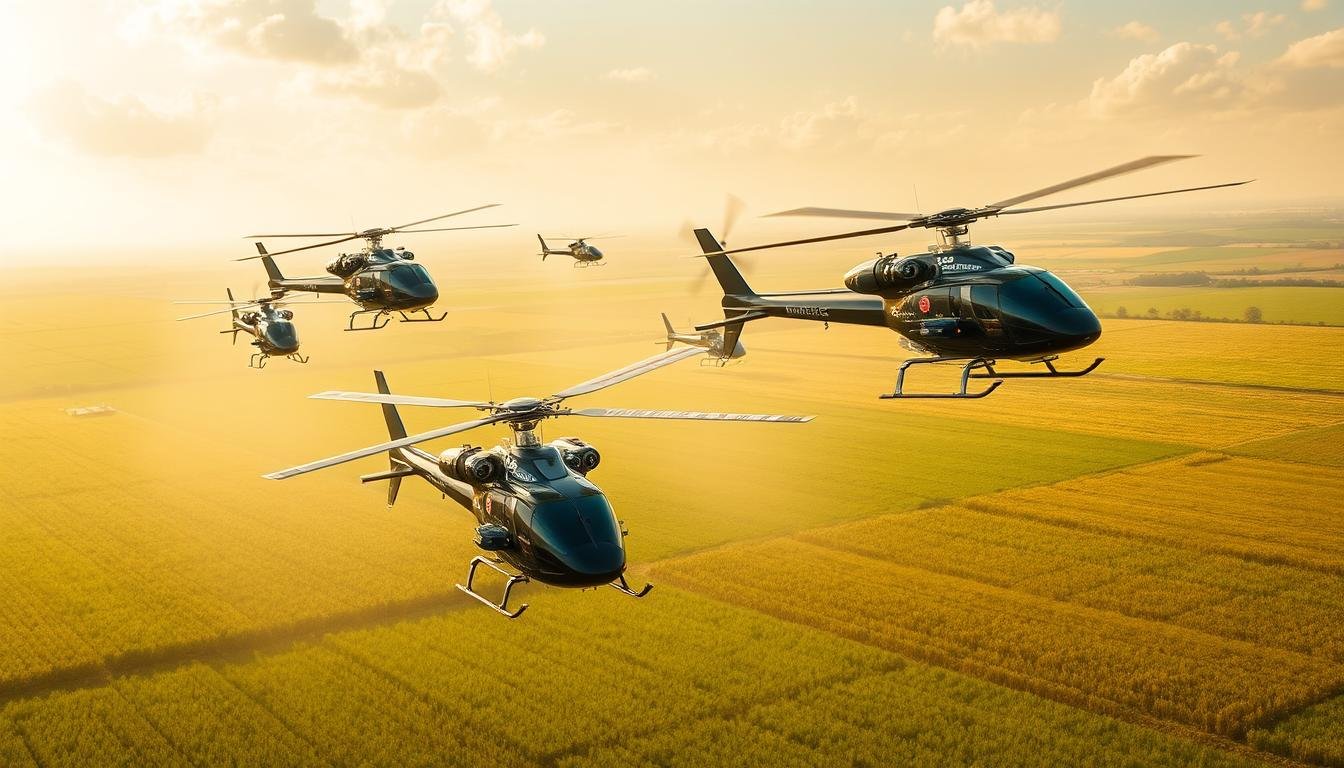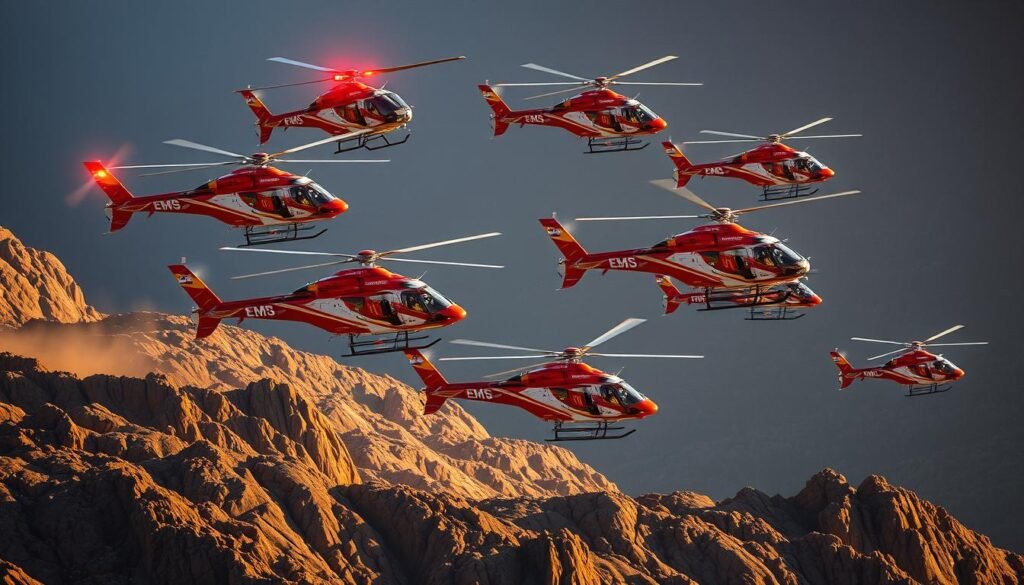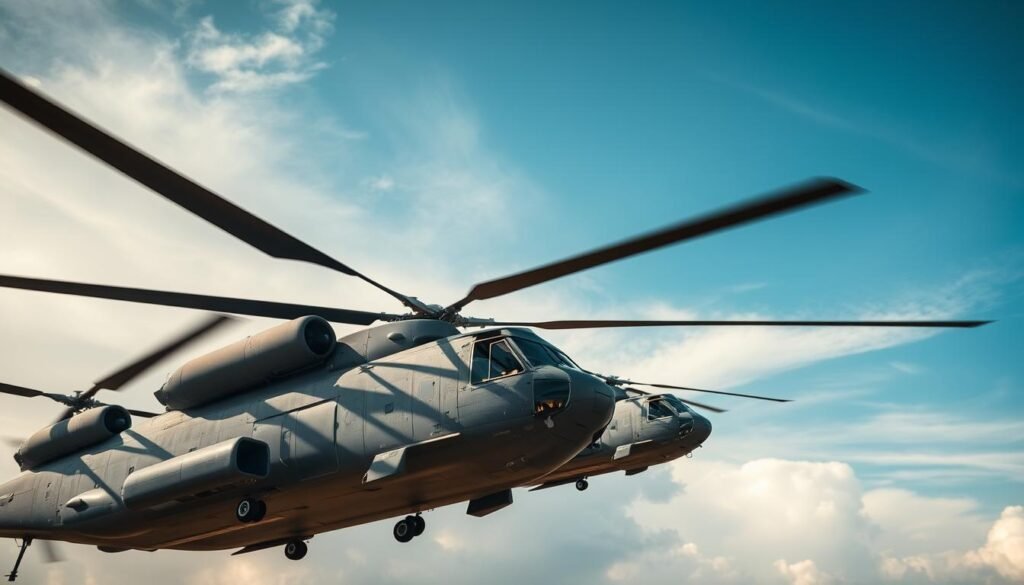Agricultural helicopters can cover an astonishing 150–200 acres per hour during tight treatment windows, a pace that changes how farmers respond to pests and disease.
That speed matters because timing can save a season’s yield. GPS-guided flight lines, optimized nozzles, and electrostatic systems improve droplet placement and cut overspray.
These aircraft avoid ground contact, so they prevent trampling and ruts on soft or uneven fields. They reach tricky terrain from the Mississippi Delta to California hills while keeping operations fast and precise.
The guide previews how to weigh per-acre costs against the benefits of reduced crop damage, labor savings, and higher productivity. It also links to practical supplier and model details, including payload and cruise specs, to match aircraft to farm needs via a concise buyer’s guide (helicopter spraying overview, model comparisons).
Key Takeaways
- Helicopter spray can treat 150–200 acres per hour, boosting response time and productivity.
- GPS routes, nozzle tech, and electrostatic systems improve uniform coverage and cut drift.
- Non-contact application prevents trampling and field ruts on soft or hilly ground.
- Ideal wind for spraying is about 3–7 mph; 500+ acre operations and high-value crops often fit best.
- Compare payload, range, and cruise speed to match aircraft performance with farm size and timing needs.
Agricultural Helicopters: Buyer’s Guide To Aerial Spraying In The United States
Deciding between owned equipment and contracted flights starts with clear metrics for acreage, timing, and cost. Buyers should map their needs by crop value, field layout, and narrow treatment windows.
This guide helps U.S. farmers match aircraft capability and aerial strategy to farm size and specific areas. Contracted services often cost more per acre but save labor and deliver speed when timing is critical.
Scope application volumes, required documentation, and desired precision before comparing bids. Field shape, access, wet soils, and topography influence tank choice, sortie planning, and consistent coverage.
Vetting providers matters. Confirm pilot credentials, insurance, and a safety-first culture. Include GPS mapping, variable-rate plans, and section control in service briefs to meet agronomic goals.
“Set performance benchmarks up front: coverage rates, drift controls, and reporting deliverables.”
- Compare total cost of ownership versus outsourced models.
- Align contracts with agronomic calendars for narrow windows.
- Require demonstrable experience on similar fields and operations.
Benefits And Use Cases Of Helicopter Aerial Spraying
Fast, reliable aerial work lets teams treat entire blocks before pests or disease spread. That speed matters when short weather windows define success. Flights that cover 150–200 acres per hour enable timely intervention across large fields and diverse terrain.
Greater Coverage And Efficiency During Short Application Windows
Routine rates of 150–200 acres per hour mean teams can finish a block in one window. This reduces re-treats and preserves yield when timing is critical.
Precision Application To Reduce Waste And Improve Distribution
GPS-guided routes and matched nozzle systems cut overspray and lower waste. Consistent track spacing produces even droplet spectra and better chemical distribution across the canopy.
No Ground Contact: Less Crop Damage And No Field Ruts
With no tires on the soil, operations avoid trampling and ruts. That prevents the 1–3% yield loss typical of ground passes during late growth phases.
Access To Tough Terrain And Variable Field Conditions
Steep slopes, saturated soils, and wetlands stay reachable when ground rigs cannot operate. Use cases include fungicide and pesticide work, foliar nutrition, desiccation, and targeted frost support.
Rotor Downwash For Canopy Penetration And Effectiveness
Downwash drives droplets into dense canopies for improved leaf contact without increasing volume. Best results come in mild winds (about 3–7 mph) and controlled droplet size to balance coverage with drift control.
- Measured outcomes: fewer re-treats and higher harvest quality.
- Practical tip: maintain consistent speed and flight lines for tall crops and irregular headlands.
- Regional fits: proven work in the Mississippi Delta, Appalachia, and California.
For operators evaluating service options, a practical resource is helicopter aerial services, which outlines common practices and control measures for precision application.
Cost, ROI, And Farm Size Fit For Aerial Application
Faster application windows translate directly into measurable savings and clearer ROI for many farms.
Per-Acre Costs, Labor Savings, And Yield Protection
At roughly 150–200 acres per hour versus ground rates of 20–40 acres per hour, aircraft deliver major efficiency and labor reductions. That speed lowers crew hours and field time, cutting labor and fuel expenses.
Hidden costs include 1–3% yield loss from wheel trampling and extra passes to reach missed areas. Non-contact delivery protects the crop and often offsets higher per-acre cost with fewer re-treats.

When Helicopters Shine: 500+ Acres, High-Value Crops, And Time-Sensitive Tasks
Large size operations (commonly 500+ acres) and high-value crops see faster break-even points. Precision application reduces chemical spend and scheduling risk during narrow treatment windows.
- Compare speed to ground rigs to quantify hourly cost savings.
- Factor in equipment wear, crew allocation, and weather delays.
- Build contingency with contracted aircraft to avoid backlogs.
Provide clear coverage, reporting, and schedule expectations when contracting to align spend with agronomic outcomes.
Top Helicopter Models For Precision Agriculture Applications
Model selection drives how many acres a team can treat per sortie and how quickly they can return to base.

Bell 206 JetRanger: Reliability, 115 Mph Cruise, And Broad Coverage
Bell 206 offers balanced performance with a 115 mph cruise, 430‑mile range, and up to 1,500 lb payload.
It suits broad coverage tasks where steady reliability and predictable sortie cadence matter.
Robinson R44: Economical Operations With Regional Range
The R44 supports cost‑sensitive operations with a 130 mph cruise, 300‑mile range, and 1,000 lb payload.
Lower operating costs make it ideal for regional runs and smaller staging areas.
MD 500 Series: High Agility For Diverse Terrains
MD 500 delivers exceptional agility with a 135 mph cruise and ~250‑mile range. Payload is up to 1,500 lb.
Its maneuverability excels for contour work and tight headlands where precision matters.
Airbus H125: High Payload Capacity And Rapid Application Speed
The H125 leads on payload and power: 2,200 lb capacity, 140 mph cruise, and a 400‑mile range.
Fewer reloads and fast transit suit large blocks and peak demand days.
Bell 47: Proven Reliability For Local Applications
Bell 47 is a robust option for local tasks, with a 105 mph cruise, 200‑mile range, and 800 lb payload.
Its simplicity and known reliability appeal for routine, short‑radius work.
| Model | Cruise (mph) | Range (mi) | Max Payload (lbs) | Best Use |
|---|---|---|---|---|
| Bell 206 JetRanger | 115 | 430 | 1,500 | Balanced coverage, steady sortie cadence |
| Robinson R44 | 130 | 300 | 1,000 | Economical regional runs |
| MD 500 Series | 135 | 250 | 1,500 | Agile contour and tight‑turn work |
| Airbus H125 | 140 | 400 | 2,200 | Large blocks, high throughput |
| Bell 47 | 105 | 200 | 800 | Local, short‑radius tasks |
Practical notes: payload and speed shape sortie cadence and nozzle choices. Buyers should match range and turnaround needs to daily acres and staging layout.
Safety, Compliance, And Best Practices For Aerial Spraying
Safe aerial work begins with strict pilot standards and enforceable protocols. Teams must combine qualified crews, documented procedures, and modern systems to protect people, crops, and property.

FAA-Licensed Pilots And Agricultural Experience
Operators should hire FAA-licensed pilots with proven field operations experience. Experienced crews improve precision and reduce risk during tight application windows.
EPA And State Rules: Drift Management And Flight Altitude
Compliance means following EPA labels and state drift rules. These rules govern altitude, buffer zones, and timing near sensitive sites.
Weather Windows: Wind, Humidity, And Timing
Target mild winds (~3–7 mph) and moderate humidity to limit drift and keep deposition on target. Teams adjust plans when conditions fall outside safe ranges.
Documented GPS Flight Paths And Coverage Verification
GPS technology and onboard systems record routes, rates, and swaths for post-application reporting. These records help audit performance and confirm full coverage.
- Ground risk is reduced with planned ingress/egress, obstacle checks, and buffer management.
- Control measures include droplet sizing, boom height relative to downwash, and electrostatic systems to improve adherence.
- Standardized tank mixing, PPE, decontamination, and radio checklists protect crews and operations.
| Safety Element | Action | Benefit |
|---|---|---|
| Pilot Currency | FAA license + field hours | Safer, precise operations |
| Regulatory Compliance | Follow EPA/state labels and buffers | Reduced legal and environmental risk |
| Weather Checks | Wind 3–7 mph, moderate humidity | Lower drift, better deposition |
| Documentation | GPS flight logs & reports | Verification and traceability |
| Controls & Systems | Droplet management, electrostatic tech | Improved uniformity and adherence |
Before awarding work, audit provider records, pilot currency, insurance, and training. For additional guidance on best practices guidance, consult this resource: best practices guidance.
Technology, Performance, And Spray System Specifications
Modern spray stacks combine mapping, droplet science, and charged delivery to lift field-level consistency.

GPS-Guided Routes, Precision Nozzles, And Droplet Control
GPS-guided routes ensure precise line spacing, minimal overlap, and documented coverage. That elevates repeatability and data integrity across varied applications.
Precision nozzle and pressure selection set droplet spectra to balance coverage with drift control. This tuning improves overall effectiveness for each pesticide or foliar task.
Electrostatic Spray Systems To Reduce Drift And Improve Adherence
Electrostatic systems charge droplets so they wrap and adhere to leaf surfaces. That reduces drift and often lowers total volume required.
“Electrostatic charging can increase deposition while cutting off-target loss.”
Speed, Range, And Payload: Matching Helicopter Performance To Field Needs
Calibrate flow, ground speed, and swath width to maintain target rates and account for rotor downwash. Matching speed, range, and payload to logistics cuts ferry time and boosts acres per hour.
- Integrate GPS logs with farm software for traceable records.
- Adjust pressure and timing in real time for temperature and humidity shifts.
- Maintain booms, filters, and strainers to prevent pattern drift.
Preflight Checklist: leak tests, calibration verification, nozzle condition, and GPS sync before each sortie.
How To Choose Services And Solutions For Agricultural Needs
Choosing the right provider begins with matching flight capability to the biology of the crop and the shape of the fields.
Align Capabilities With Crop And Field Size. Selection starts by mapping your agricultural needs to aircraft that match payload, endurance, and agility for the crop mix and field complexity. Match platform range and tank size to daily acres and staging layout.

Aligning Helicopter Capabilities With Crop, Field Size, And Timing
Vet Services For Peak Capacity And Reliability. Buyers should confirm on-call availability, documented task execution on similar crops, and recorded uptime histories. Shortlist providers with backup aircraft and pilot hours specific to aerial application.
- Fit the solution to application type — fungicide, nutrient, or pesticide — and verify nozzle packages and droplet targets meet label requirements.
- Plan staging and nurse‑truck routes so the helicopter can turn quickly without creating safety risks.
- Require GPS-recorded coverage, rate maps, and post-flight reports to satisfy audits and retailer documentation.
- Prioritize teams with proven timing discipline to mobilize when pest or disease pressure spikes.
- Consider terrain: choose platforms with the agility to hold consistent swaths over irregular headlands and obstacles.
“Documented flight logs and clear communication protocols between agronomists and flight crews are essential for reliable, time-sensitive work.”
Contract Terms And Communication. Align contracts to agronomic calendars and reserve capacity for time-sensitive passes. Establish direct comms between scouts, agronomists, and flight crews to synchronize rates and timing decisions.
Conclusion
Fast, documented spray runs turn narrow weather windows into predictable treatment outcomes. Agricultural helicopters that deliver 150–200 acres per hour convert speed and range into dependable coverage during critical times.
The combination of GPS-logged flight paths, tuned nozzle setups, and electrostatic systems improves precision and cuts drift. By avoiding ground contact, operators protect crops and prevent the 1–3% trampling loss common with ground rigs.
Decision-makers should match size, payload, and speed to daily acres, then lock in providers who can mobilize quickly. Demand GPS flight logs and coverage proofs so spray work ties directly to agronomic outcomes and clear costs versus benefits.
FAQ
What tasks do helicopters perform in aerial spraying and crop management?
They apply pesticides, foliar nutrients, and biologicals across large fields quickly. Operators use GPS-guided routes and precision nozzles to control droplet size and distribution, improving coverage and reducing waste compared with ground rigs. Rotor downwash also helps canopy penetration for dense crops.
When does using a helicopter make financial sense for a farm?
Helicopter application becomes cost-effective on large operations—typically 500+ acres—high-value crops, or when timing is critical, such as tight pest windows. Savings come from faster turnaround, lower labor needs, and reduced crop damage, which can protect yield and justify higher per-acre costs.
Which helicopter models are commonly used for precision application?
Common choices include the Bell 206 JetRanger for reliability and speed, the Robinson R44 for economical regional work, the MD 500 series for agility in varied terrain, Airbus H125 for higher payloads and rapid application, and legacy types like the Bell 47 for local tasks. Selection depends on payload, range, and field size.
How do operators minimize spray drift and ensure compliance?
Pilots follow EPA and state regulations, use electrostatic systems and drift-reducing nozzles, and fly within prescribed altitude and weather windows. Documented GPS flight paths and real-time monitoring verify coverage and help meet regulatory reporting requirements.
What are typical performance limits — speed, range, and payload — that affect coverage?
Cruise speeds vary by model; for example, the Bell 206 can cruise near 115 mph, while smaller aircraft are slower. Range and payload depend on fuel and tank capacity; higher-payload helicopters cover more acres per load, reducing return trips and increasing daily throughput.
How does rotor downwash influence spray effectiveness?
Downwash pushes droplets into the canopy, improving deposition on lower leaf surfaces and reducing the need for higher application volumes. Proper nozzle selection and flight height are essential to harness downwash without increasing drift.
What safety and operational qualifications should a service provider have?
Providers should employ FAA-licensed pilots with agricultural spraying experience, maintain aircraft to industry standards, and carry liability insurance. They must also follow documented safety plans, pre-flight checks, and chemical handling protocols to protect people and the environment.
How do GPS-guided routes and spray systems improve precision?
GPS guidance enables consistent, repeatable flight lines, overlap control, and exclusion zones. Integrated systems can modulate flow rate and nozzle selection on the fly, matching application rates to field maps and reducing input waste.
Can helicopters access fields that ground rigs cannot?
Yes. They reach steep slopes, wet soils, and fragmented parcels without causing ruts or compaction. This agility makes them valuable for spot treatments, variable-rate applications, and emergency response when ground access is limited.
What factors determine per-acre cost and return on investment?
Costs reflect aircraft type, chemical load, flight time, and logistics. ROI depends on yield protection, time-sensitive control of pests or disease, and reduced labor and equipment wear. High-value crops and tight windows typically deliver the strongest ROI.
How is weather accounted for in planning aerial applications?
Pilots monitor wind speed and direction, humidity, and temperature to choose optimal windows. Early morning or late afternoon often reduces drift. Operations can be delayed or rescheduled if conditions risk off-target movement or poor deposition.
What maintenance and reliability considerations affect choice of platform?
Operators evaluate parts availability, maintenance intervals, and proven service records. Models with wide dealer networks, such as Bell and Airbus types, often offer faster turnaround for parts and qualified technicians, improving uptime during peak seasons.
How do electrostatic spray systems benefit farmers?
Electrostatic charge helps droplets adhere to plant surfaces, increasing coverage while allowing lower volumes. That reduces chemical use and drift, improving efficacy and cost-efficiency, particularly for foliar applications and orchard work.
What should a farmer ask when hiring an aerial application service?
Ask about pilot credentials, equipment models, insurance, GPS mapping and documentation capabilities, drift mitigation practices, chemical handling procedures, and references. Clear communication about target areas and sensitive sites ensures safer, more effective applications.
Related Articles
- Medical Transport Helicopters: Critical Features and Models for Emergency Flights
- Helicopter Drones: The Future of Unmanned Aerial Systems
- Helicopters for Offshore Oil and Gas Operations: Transporting Workers and Equipment
- Helicopters in Tourism: The Best Models for Scenic Tours
- Helicopters for Police and Law Enforcement: Surveillance and Patrol Capabilities
More from This Category
- The Evolution of Attack Helicopters: Key Models and Their Capabilities
- Utility Helicopters: The Workhorses of the Sky
- Trainer Helicopters: The Best Models for Learning to Fly
- Helicopters for Aerial Photography and Filmmaking: Top Picks for Capturing the Perfect Shot
- Luxury Helicopters: The Best Models for Private and Corporate Use
- Heavy Lift Helicopters: Moving Large Cargo and Equipment
- Agricultural Helicopters: Aerial Spraying and Crop Management
- Rescue and EMS Helicopters: How They Save Lives in Critical Situations
- Military Helicopters: Key Models and Their Combat Roles
- The Different Types of Helicopters: From Light Utility to Heavy Lift



